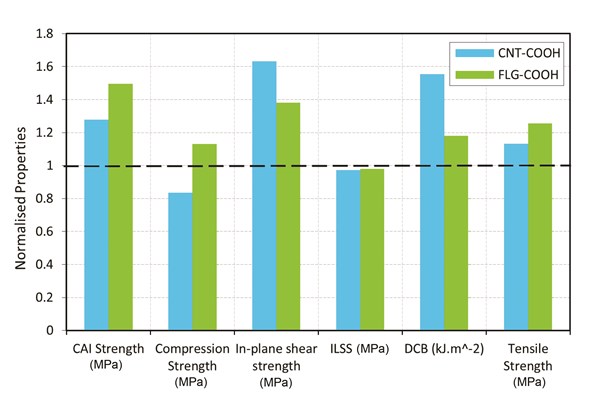Graphene-toughened composites
Are we getting closer to commercialized, and functional, nanotechnology?

Test results for composites made with carbon nanotube carboxylic acid (CNT-COOH) and few layered graphene carboxylic acid (FLG-COOH) show that adding nanomaterials increases compression strength 13 percent vs. normalized properties and boosts CAI by 50 percent. SOURCE: Cardiff University.
The School of Engineering at Cardiff University and graphene specialist company (Carmarthenshire,U.K.) recently announced new research demonstrating significant improvements in mechanical performance of composites, including impact resistance, using plasma-treated graphene nanoplatelets (GNP).The research was undertaken by the Cardiff School of Engineering with additional funding from the European Community’s Seventh Framework program under the , aimed at greener aircraft design. The project included the, and was managed by an integrated team from CIRA, Cardiff School of Engineering and Haydale.
The research investigated graphene nanoplatelet (GNP) and carbon nanotube (CNT) reinforcement technology. The results observed in this research show a 13 percent increase in compression strength and a 50 percent increase in compression after impact (CAI) performance (see graph above), indicating that fracture mode has been positively influenced, say researchers.
A resin infusion technique was employed to produce composites containing a small percentage of nanomaterials. Significantly, the nanomaterials were surface treated using Haydale’s trademarked low temperature, low energy HDPlas plasma process, which promotes homogenous dispersion and chemical bonding, without waste. The low pressure plasma process can treat both organic mined fine powder and other synthetically-produced nanomaterial powders, producing high quality few-layered graphenes and graphene nanoplatelets. Haydale says the process can functionalize with a range of chemical groups, where the amount of chemicals can be tailored to customer needs. Good dispersion improves the properties and performance of the host resin. The plasma process does not use wet chemistry, neither does it damage the material being processed. Energy requirements are low and the process is reportedly environmentally friendly.
Ray Gibbs, CEO of Haydale, says “These exceptional results underline the potential of Haydale’s tailored, plasma functionalization process in delivering a scalable technology for the production of superior composites. We believe that by working closely with the Cardiff School of Engineering, our combined resources and expertise can significantly accelerate graphene optimization.” Professor Sam Evans from the School of Engineering, Cardiff University, agrees, saying “This research represented a fantastic opportunity for the team at Cardiff to work with graphene materials and technology. Graphene technology has enormous potential for improving the performance of aircraft materials. These initial results suggest that there may be the potential for big weight reductions in aircraft and many other applications, which is very promising.”
Let’s hope that the research comes to fruition. There are many commercialization challenges in moving beyond the lab, and costs of these GNPs has traditionally been very high, as noted by Lux Research senior analyst Ross Kozarsky in the 2013 HPC article, "Graphene: Ready for prime time?". For nanotechnology to benefit composite fabricators, the costs must come down.
One promising nanotechnology product is offered by (U.S. offices in Palo Alto, Calif. and Columbus, Ohio), an exhibitor at the recent conference and exhibition (Oct. 13-16, Orlando, Fla.). The company can produce single-wall carbon nanotubes (SWCNTs), trademarked Tuball, promoted as a “universal nanomodifier” additive for many types of materials, at a mass industrial scale in a reportedly continuous process. The company offers the Tuball product at the incredibly low price of $2 per gram, according to its Web site. Others are also bringing less expensive products to the market as reported in the . Perhaps greater adoption of nanotechnology forms for better-performing composites will soon be a reality.
Related Content
Welding is not bonding
Discussion of the issues in our understanding of thermoplastic composite welded structures and certification of the latest materials and welding technologies for future airframes.
Read MoreIndustrializing additive manufacturing in the defense/aerospace sector
GA-ASI demonstrates a path forward for the use of additive technologies for composite tooling, flight-qualified parts.
Read More“Structured air” TPS safeguards composite structures
Powered by an 85% air/15% pure polyimide aerogel, Blueshift’s novel material system protects structures during transient thermal events from -200°C to beyond 2400°C for rockets, battery boxes and more.
Read MoreThe next-generation single-aisle: Implications for the composites industry
While the world continues to wait for new single-aisle program announcements from Airbus and Boeing, it’s clear composites will play a role in their fabrication. But in what ways, and what capacity?
Read MoreRead Next
Cutting 100 pounds, certification time for the X-59 nose cone
Swift Engineering used HyperX software to remove 100 pounds from 38-foot graphite/epoxy cored nose cone for X-59 supersonic aircraft.
Read MoreNext-gen fan blades: Hybrid twin RTM, printed sensors, laser shock disassembly
MORPHO project demonstrates blade with 20% faster RTM cure cycle, uses AI-based monitoring for improved maintenance/life cycle management and proves laser shock disassembly for recycling.
Read MoreCeramic matrix composites: Faster, cheaper, higher temperature
New players proliferate, increasing CMC materials and manufacturing capacity, novel processes and automation to meet demand for higher part volumes and performance.
Read More












